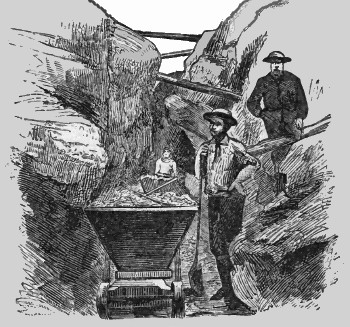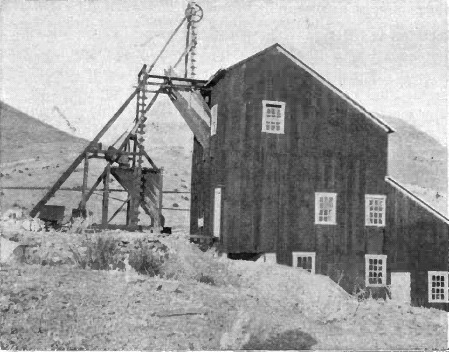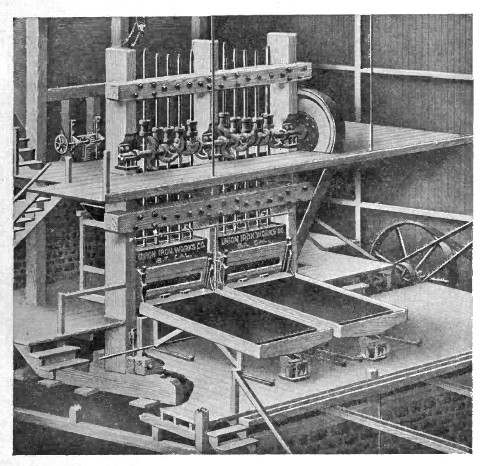Where gold will amalgamate to the extent of 20% or more, amalgamation, preferably in water, may be practiced. If the ore will not amalgamate to this extent and requires cyanide treatment, amalgamation had better be dispensed with unless some of the amalgamable gold is coarse and escapes the cyanide plant through the inability of cyanide solution to dissolve coarse gold. The coarse gold in an ore that is finely ground in cyanide solution by a tube-mill can be expected to be ground so fine that none will escape the cyanide plant without being dissolved. Crushing in cyanide solution is a great aid to cyaniding, as the ore is brought promptly into contact with the solution, and under conditions that cause the precious metals to go into solution quickly, thus requiring less tankage for dissolving the gold. It also permits using a certain amount of water in washing the dissolved gold and silver out of the pulp to compensate for the moisture discharged in the tailing. This makes a saving in the amount of cyanide mechanically lost, and in practice also effects a saving in the amount of dissolved gold mechanically lost. Crushing in solution has its disadvantages in that the solution throughout the mill is carrying quite an amount of gold ; and a little of this solution is constantly being lost, even in well designed mills, by the leakages, overflows, accidents, and otherwise. There is an abnormally large volume of solution to be cared for, pumped, and precipitated, which makes a material increase in the costs per ton of ore treated.
Another disadvantage of crushing in cyanide solution in a mill where amalgamation is being practiced, is that a part of the gold goes into solution which would be amalgamated if the crushing was done in water. If this gold was amalgamated, practically all of it would be returned, but by going into solution the proportion returned is lessened, both through the losses above referred to, and through the indifferent washings of the filtering devices used. The amount of gold going into solution that could otherwise be obtained by amalgamating in water will vary with the size of the particles of gold ; thus with an extremely fine gold crushed in strong cyanide solution as much as one-third or one-half of the amalgamable gold may be dissolved so quickly that it cannot be amalgamated. In such a case it is inadvisable to crush in cyanide solution. Where the gold is coarse and but little of the amalgamable gold enters the solution, crushing in solution may be advisable, depending on the character of the cyanide plant and the perfection of its operation in gathering all of the dissolvable precious metal into the clean-up. Where the sulfide minerals are amenable to cyanide treatment and they are small in amount or low in value, it may be expedient to cyanide it with the sand without concentration, offsetting the decreased extraction from this sulfide by the lessened cost of treatment. At one prominent property operating along this line, a high discharge is used to retain the sulfide longer in the mortar, that it may give a higher extraction in the cyanide plant through being crushed fine, while a large amount of water is used in the mortar to increase the tonnage and thus compensate for the decrease due to the high discharge.
Economic problems must be studied when considering amalgamation and cyanidation. With a small mill of 10 or 20 stamps obtaining a good extraction by amalgamation and concentration, it may not be advisable to put in a cyanide plant taking the pulp directly, on account of the high cost per ton of capacity for installing and operating a small plant of this type. It may be better to run the tailing into a pond and later put in, at less tonnage expense, a leaching plant of large capacity. With a pulp crushed through a 30 or 40-mesh screen and properly impounded, it is possible to extract practically all of the dissolvable gold and silver. In a country of average working costs, an impounded tailing having a value of 80c. per ton and giving an extraction of 80% will return a good margin of profit. As the plate or concentrator tailing becomes higher, the necessity for a plant to treat it directly increases, since the tailing, pond will hold a large amount of money that is not available, and there is a loss from the sand blown away and an occasional breaking of the dam. A tailing pond is sometimes a desirable thing to a manager, or promoter, as when it figures prominently too prominently usually in the report of the assets and possibilities of the company's property. Regrinding of the pulp followed by amalgamation (secondary amalgamation) may reduce the value of the tailing to a point so low that it may not be profitable to cyanide it, and this point should be looked into when making the tests preliminary to designing the mill. For this purpose some form of grinding pan, a Chilean mill, or the slow-speed roller mill, that will admit of amalgamation within the mill, may be recommended. The tube-mill has been found the most satisfactory machine for fine grinding for cyanidation. It was formerly considered a poor machine for amalgamating purposes, since any mercury fed to it, as well as the gold which is liberated, is supposed to come out thoroughly slimed. But this idea is passing away, for excellent outside amalgamation can be effected after the tube-mill, as due to the fineness of the pulp, a beautifully thin flow can be had over the plates. When crushing in cyanide solution the grinding and sliming action within .the mill causes so much of the gold to go into solution that it is usually not worth while to try amalgamation afterward.
From a theoretical standpoint it would appear that where amalgamation or concentration is to follow the tube-mill, the mill should be run at a speed that will cause the balls to be carried part way around and to crush by their falling impact, rather than the slower rate of speed whereby comminution is effected by the attrition or rolling and grinding of the pebbles alone. The first is a case of cracking open the grains and liberating the gold or sulfide as a relatively large angular particle susceptible of easy amalgamation or concentration, whereas the second results in the scaly, impalpable, unmanageable slime produced by attrition. The first is illustrative of the principle of the stamp, the second that of the grinding mill. An appreciation of these principles will lead to a better understanding of the reason for the supremacy of the stamp-mill. "Within recent years fine-grinding and 'all-sliming,' invariably connected with crushing in solution, have rapidly come into vogue. In most cases it has been advisable, but in many instances these methods have been employed because it has been the fad, or because filtering devices were installed that required them. This is clearly wrong. Fine-grinding should not be carried beyond the economic point. The cost of finer comminution increases rapidly, whether by stamp, Chilean mill, tube-mill, or other device. The degree of fineness that will give the highest extraction in the laboratory is not necessarily the one that will give the most profit. The milling and cyaniding machinery should be susceptible of adaptation to the economic requirements, and the mill man or metallurgist should possess the ability to find them.
It may be given as a rule of broad application that the higher the grade of the ore and the baser it is toward amalgamation, the better adapted it is for all-sliming and crushing in solution; while the lower the grade and the less base it is toward amalgamation, the less adapted it will be to those methods. For as the grade of ore increases the percentage of extraction will also increase somewhat, but the value of the tailing in dollars and cents will likewise increase. Finer grinding will reduce the amount in the tailing, at least when cyanidation is used; but as the ore becomes lower in grade the additional amount won from the ore by finer grinding rapidly grows less until it is overbalanced by the increased cost of finer grinding. It is an open question as to whether crushing in solution decreases the working costs per ton, but we will suppose a case in which it does and in which cyanidation is necessary. At first sight it would appear best to dispense with amalgamation and catch the gold by one process only that of cyanidation but the cost of amalgamating and the almost negligible loss of gold in amalgamating varies but slightly with the amount of gold amalgamated per ton; whereas the working costs per ton by cyanidation increase as more gold is dissolved per ton, because of the more elaborate equipment required in the attempt to obtain all the dissolved gold, also because the mechanical loss of gold grows greater as the amount dissolved per ton of ore increases. Thus it follows that as the amount that can be amalgamated increases, the advisability of crushing in solution decreases. The correctness of this principle is. Indicated by the reversion from attempting to remove the dissolved gold from the ore solely by filter washing, to the method of separating as much gold as possible from the ore by preliminary decantations before sending the pulp to the filter for final washing.
What better method than amalgamation is there for reducing the value of the pulp going to the filter, and lessening the mechanical loss and perhaps the working costs throughout the whole process of cyanidation? It is a fact that crushing in solution has been generally unsatisfactory on low-grade ore, and there do not appear to be any plants operating under such conditions today or at least any that are widely known outside of the Black Hills, yet there are many plants employing final cyanidation on low-grade ore. The question now comes, if crushing in solution has to give way to other methods on low-grade ore, why are not these other methods more economical on higher grade ore? Various factors enter into the consideration of this matter, but the principal reason why no satisfactory answer has yet been made appears to be that the metallurgists who should give us the answer are too busy boosting special processes in which they are interested.
There have been a number of mills built to employ these methods which have not proved successful. These have usually been small mills, either not elaborately and carefully designed or embodying some rather new and untried devices. The best way to handle these 'novelty mills' is to go back to proved methods. Crush in water and amalgamate, following with regrinding and secondary amalgamation. Get all that can possibly be obtained by amalgamation, for that will be 'absolute,' at least in so far that loss of amalgamable gold cannot be detected after the careful amalgamator, except by the 'eyes' of amalgam appearing in the tailing flume. Then take the tailing to the cyanide plant and do the best that can be done with the machinery available. The idea should be borne in mind in designing and erecting and in starting a new mill; the arrangements should be such that the crushing may be done either in water or solution, and it is generally wise to start crushing in water and effect the change to crushing in solution after the metallurgical system and the mill equipment have been tried out.
In general, mills should be designed and built along tried and proved lines, for then it can be foretold with confidence just what the mill will accomplish, especially in a mechanical way. Thus the successful experience of others can be utilized, and should some unlocked for difficulty arise, precedents will be at hand for solving it. Such a mill can be started without a long and costly siege of loss of time, worry, experiments, and alterations, and new employees will require little coaching. Science is the accumulated knowledge of the ages from which the errors have been removed, the rough places straightened out, the shoals marked, and the principles made clear. He who follows in its footsteps can expect a fair measure of success, but he who throws his fortunes with what science and practice have not yet indicated as safe, has left the lighted way and may expect a hard path and usually disaster. Scientific mill designing consists in following the lighted way, and if this does not promise a sufficient measure of success, then surely the untried way is one of danger. To be more concrete, scientific mill designing and operation consists in three things: First, thoroughly testing the ore until all necessary information is obtained. Second, designing and building a mill which embodies those ideas and those particular devices which practice linked with science have indicated to be the most reliable and advantageous for each particular part and purpose. Third, after the mill has been placed in successful operation along conservative lines, experimenting and testing with various machines, devices, and expedients the original design of the mill to include the idea of facilitating this to increase tonnage and extraction and to decrease costs. The first two will insure a successful mill. The last will greatly prolong the life of the mine, for a consideration of the mines famous for long and continuous production will show that they are operating on low-grade ore with a remarkably small margin of profit per ton, and a margin due to a scientific reduction of costs and increase of extraction begun while the mine was in good ore.
Return To:
Hard Rock Quartz Mining and Milling



